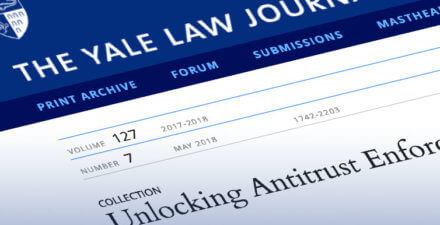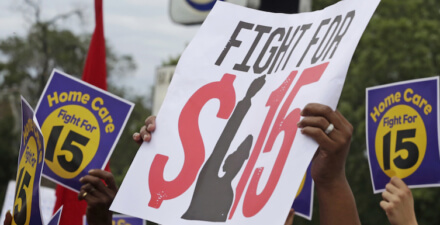Brad DeLong: Worthy reads on equitable growth, December 19, 2018–January 3, 2019
Worthy reads from Equitable Growth:
- If you have not already read all of the Washington Center for Equitable Growth’s top 12 of 2018, go read them at “Equitable Growth’s Top 12 of 2018.”
- The Joint Tax Committee should do what Greg Leiserson and Adam Looney recommend in “A framework for economic analysis of tax regulations” beginning today. They write: “The economic analysis conducted in these cases should focus on the revenues raised and the economic burden imposed on the public as a result of the agencies’ exercise of discretion or the new application of existing authority. The revenues raised and the burden imposed reflect the fundamental tradeoff in taxation, and thus determine a regulation’s costs and benefits. However, the analysis should not attempt to quantify the net benefit or net cost of a regulation, as doing so would require the agencies to make controversial assumptions about the social value of revenues and the appropriate distribution of the tax burden. Treasury’s Office of Tax Analysis is well-equipped to provide estimates of revenues and burden, as they can be built from analyses the Office already produces: revenue estimates, distributional analyses, and compliance cost estimates.”
- We here at Equitable Growth are certainly doing a good job of picking our grantees. Read Corey Husak’s tweet “So excited and honored,” in which he notes that five of the eight best young economists named by The Economist are Equitable Growth grantees.
- If you want to join some future such list of eight, take a look at our current Equitable Growth “Request for Proposals.”
Worthy reads not from Equitable Growth:
- Robert Bork and his followers hold to the poisonous belief that the test for anticompetitive behavior is whether it could be declared anticompetitive “in theory” beyond a reasonable doubt. And here we see people having to argue against it again in a new context. Read Jonathan B. Baker and Fiona Scott Morton, “Antitrust Enforcement Against Platform MFNs,” in which they write: “Antitrust enforcement against anticompetitive … pricing parity provisions … can help protect competition in online markets … These contractual provisions may be employed by a variety of online platforms offering, for example, hotel and transportation bookings, consumer goods, digital goods, or handmade craft products. They have been the subject of antitrust enforcement in Europe but have drawn only limited antitrust scrutiny in the United States. Our feature explains why MFNs employed by online platforms can harm competition by keeping prices high and discouraging the entry of new platform rivals, through both exclusionary and collusive mechanisms, notwithstanding the possibility that some MFNs may facilitate investment by limiting customer freeriding.”
- Perhaps Congress’ Pay-as-You-Go principle made some sense in the 1990s, when there were Republican, as well as Democratic, legislators willing to take it seriously. And you can argue that adopting it is a public relations rather than a substantive exercise—the House can waive it with a simple majority, and the Senate can waive it as easily as it can overcome a filibuster. So, if there are the votes to circumvent the other procedural hurdles, there are the votes to waive PAYGO when it is desirable. But it is a strange thing to make a priority. Read Josh Bivens’ take on this in “The Bad Economics of PAYGO Swamp Any Strategic Gain from Adopting It,” in which he writes: “A PAYGO rule means that any tax cut or spending increase passed into law needs to be offset in the same spending cycle with tax increases or spending cuts elsewhere in the budget … Many Washington insiders assert forcefully that committing to PAYGO rules in the House for the next Congress is good politics … The strength of evidence supporting this political claim is debatable. What’s less debatable is that PAYGO really has hindered progressive policymaking in the not-so-recent past. For example, it was commitments to adhere to PAYGO that led to the Affordable Care Act having underpowered subsidies for purchasing insurance and, even more importantly, having a long lag in implementation.”
- That neither the Bernanke nor the Yellen Fed rethought its commitment to its—asymmetric!—2 percent per year inflation target has always been a mystery to me. The former president of the Federal Reserve Bank of Minneapolis recently outlined some of the risks. Read Narayana Kocherlakota, “The Fed’s Risky Plan to Boost Unemployment,” in which he writes: “The Fed is planning to raise its interest-rate target above its long-run level of around 2.8 percent. We can actually see this happening in the Fed’s rate forecasts for the next 3 years … The Fed is planning to eliminate over a million jobs—and put millions more at risk—in order to avoid a tiny deviation from its inflation target. I’ll leave it for readers to judge whether this is a desirable gamble.”
- I confess I was split between thinking that (small) increases in minimum wages have no noticeable effect lowering employment because labor-supply curves are typically nearly vertical and thinking that (small) increases in minimum wages raise employment because they curb employer market power. But the evidence continues to pile up that Card and Krueger are right, and that it is the second—that there is no downside to raising minimum wages at all. Read Barry Ritholtz, “What Minimum-Wage Foes Got Wrong About Seattle,” in which he writes: “An initial study said the increase to $15 would cost workers jobs and hours. That didn’t happen … The increase was an ‘economic death wish’ that was going to tank the expansion and kill jobs, according to the sages at conservative think tanks. The warnings were as unambiguous as they were specific.”





